Don't go crazy with the wet towel
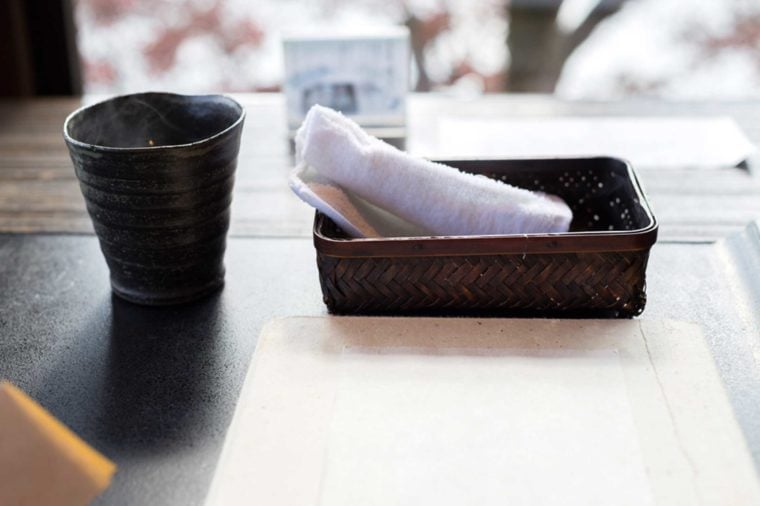 Many restaurants provide you with a wet towel right after you get seated. While that steaming hot sensation may ignite your every desire to stop, drop, and spa, do not use the towel on your face or neck. The towel is solely meant to clean your hands. Once you have done this, simply fold it and put it aside. "The wet towel is there because you are expected to eat everything with your hands and wipe your fingertips with the towel as you go," Chase Kojima, executive chef at Sydney-based Sokyo, told the Australian website SBS.
Many restaurants provide you with a wet towel right after you get seated. While that steaming hot sensation may ignite your every desire to stop, drop, and spa, do not use the towel on your face or neck. The towel is solely meant to clean your hands. Once you have done this, simply fold it and put it aside. "The wet towel is there because you are expected to eat everything with your hands and wipe your fingertips with the towel as you go," Chase Kojima, executive chef at Sydney-based Sokyo, told the Australian website SBS.
Slurp away!
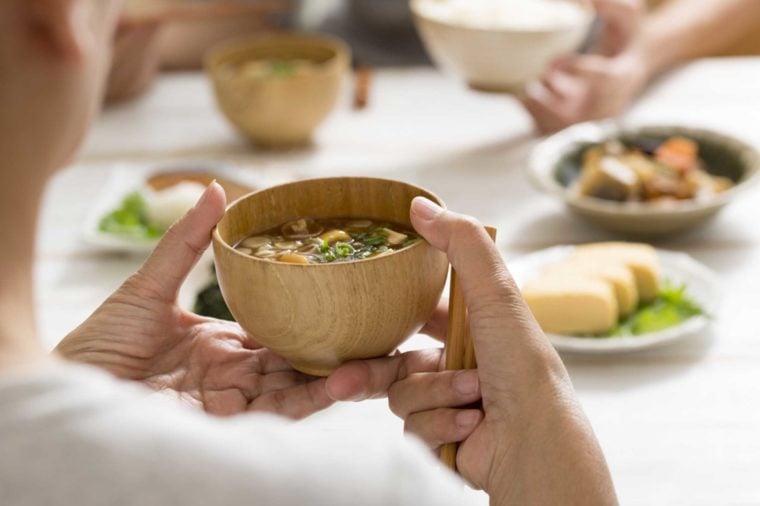 It's generally considered rude in American culture to pick up your bowl of soup and slurp like it's your last meal on earth (soup is one of those tricky foods to eat in a polite manner). But this is not the case with Japanese etiquette. In fact, it's encouraged to lift your miso-filled bowl to your mouth, using the spoon with the other hand to scoop up the goodness. Chefs consider the slurping noise to be a sign of contentment, so don't be surprised if you hear a lot of this noise throughout the restaurant! And feel free to make your own.
It's generally considered rude in American culture to pick up your bowl of soup and slurp like it's your last meal on earth (soup is one of those tricky foods to eat in a polite manner). But this is not the case with Japanese etiquette. In fact, it's encouraged to lift your miso-filled bowl to your mouth, using the spoon with the other hand to scoop up the goodness. Chefs consider the slurping noise to be a sign of contentment, so don't be surprised if you hear a lot of this noise throughout the restaurant! And feel free to make your own.
Never drink alone
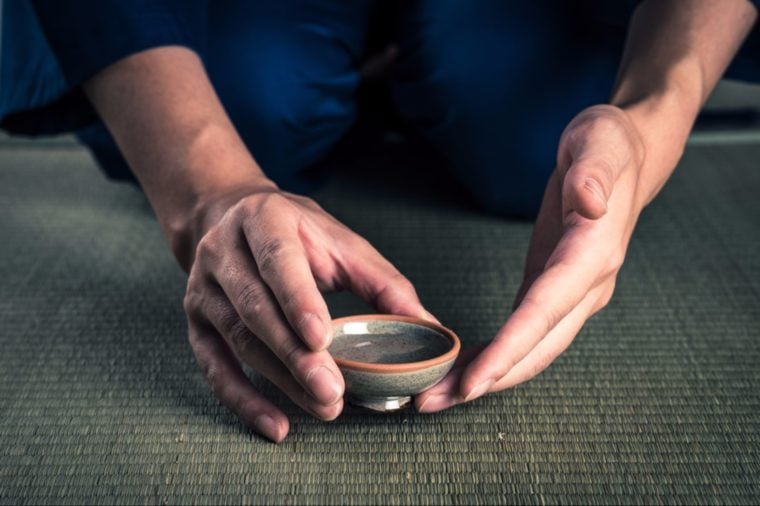 The sake and beer flows at Japanese restaurants, as any sushi lover surely knows. But be mindful not to drink alone. The proper etiquette here involves waiting on all glasses to be filled, and then allowing one member to give a toast, or simply say kanpai, which means cheers in Japanese. After raising your glass, return the kanpai, and then drink (but always in moderation, as too much alcohol has these negative health effects). Insider tip: The Japanese are big on pouring drinks for each other, so take note and allow a friend to fill up your glass; then you fill up theirs. It's looked down upon to pour your own drink!
The sake and beer flows at Japanese restaurants, as any sushi lover surely knows. But be mindful not to drink alone. The proper etiquette here involves waiting on all glasses to be filled, and then allowing one member to give a toast, or simply say kanpai, which means cheers in Japanese. After raising your glass, return the kanpai, and then drink (but always in moderation, as too much alcohol has these negative health effects). Insider tip: The Japanese are big on pouring drinks for each other, so take note and allow a friend to fill up your glass; then you fill up theirs. It's looked down upon to pour your own drink!
Don't rub your chopsticks together
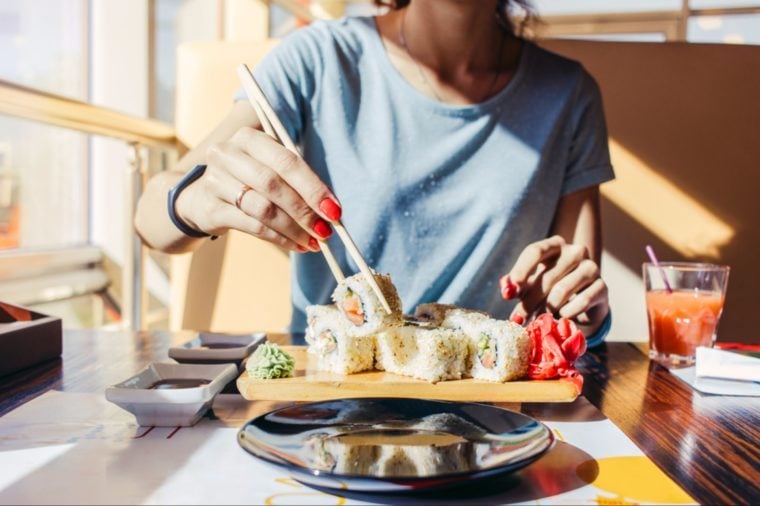 Are you guilty of tearing your wooden, disposable chopsticks out of their paper packaging and rubbing them together to get rid of splinters? If so, you might be guilty of not even looking at the chopsticks first, warns Regional Corporate Chef John Um of Sushisamba in Las Vegas, Nevada. The problem with this behavior is that it's considered an insult. It tells the restaurant that you think the chopsticks are of poor quality. If you do find a splinter in the wood, however, just ask for a new pair of chopsticks.
Are you guilty of tearing your wooden, disposable chopsticks out of their paper packaging and rubbing them together to get rid of splinters? If so, you might be guilty of not even looking at the chopsticks first, warns Regional Corporate Chef John Um of Sushisamba in Las Vegas, Nevada. The problem with this behavior is that it's considered an insult. It tells the restaurant that you think the chopsticks are of poor quality. If you do find a splinter in the wood, however, just ask for a new pair of chopsticks.
Never stand your chopsticks upright in your rice
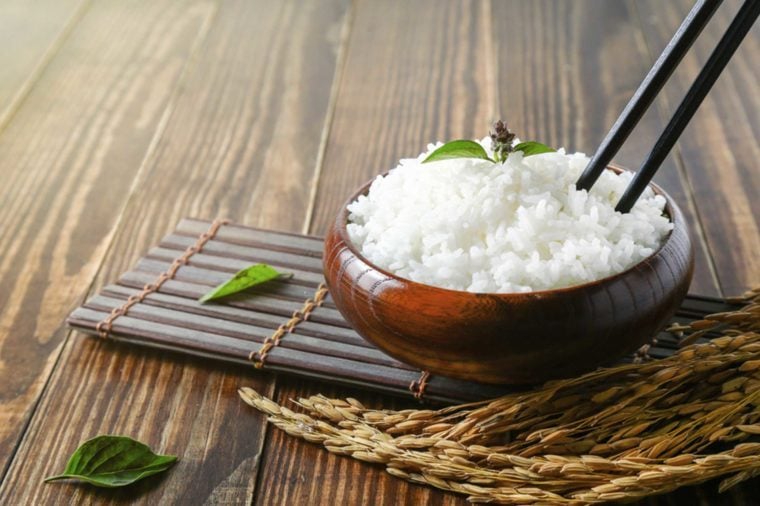 Sometimes you just don't know what to do with your silverware, and the same can be said about chopsticks. You get so caught up just enjoying the food, that when it's time to take a break, you just want to jam the sticks in the bowl of rice and take a breather. But don't! Standing chopsticks upright in a bowl of rice is a big no-no because during funerals in Japan, a bowl of rice with upright chopsticks is placed before the coffin of the deceased. Instead, place your chopsticks together right in front of you, parallel to the edge of the table.
Sometimes you just don't know what to do with your silverware, and the same can be said about chopsticks. You get so caught up just enjoying the food, that when it's time to take a break, you just want to jam the sticks in the bowl of rice and take a breather. But don't! Standing chopsticks upright in a bowl of rice is a big no-no because during funerals in Japan, a bowl of rice with upright chopsticks is placed before the coffin of the deceased. Instead, place your chopsticks together right in front of you, parallel to the edge of the table.
Don't pass food with your chopsticks
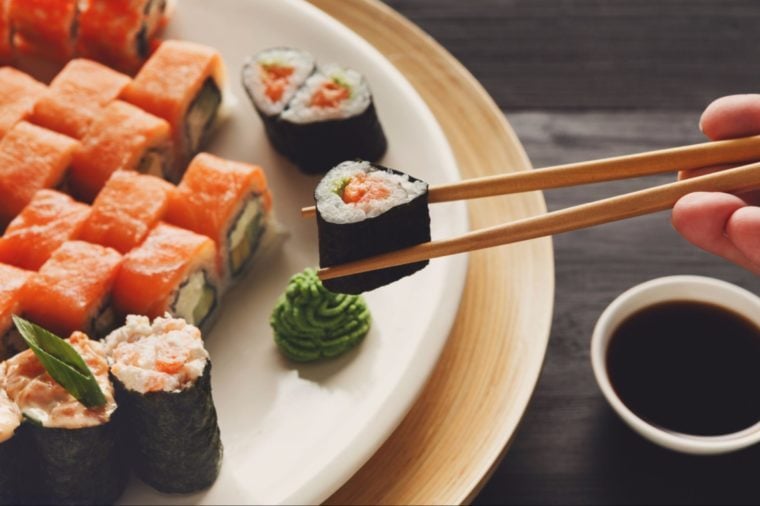 In American culture, handling food is often frowned upon, unless, say it's a burger, French fry, chicken wing or other designated finger food. But just because you have chopsticks doesn't mean they function the same as a fork. Passing food using chopsticks is frowned upon because it reminds Japanese of the ritual of passing cremated bones between chopsticks at a funeral. To share bites, place them on a small plate and pass the plate.
In American culture, handling food is often frowned upon, unless, say it's a burger, French fry, chicken wing or other designated finger food. But just because you have chopsticks doesn't mean they function the same as a fork. Passing food using chopsticks is frowned upon because it reminds Japanese of the ritual of passing cremated bones between chopsticks at a funeral. To share bites, place them on a small plate and pass the plate.
Eat in the "correct" order
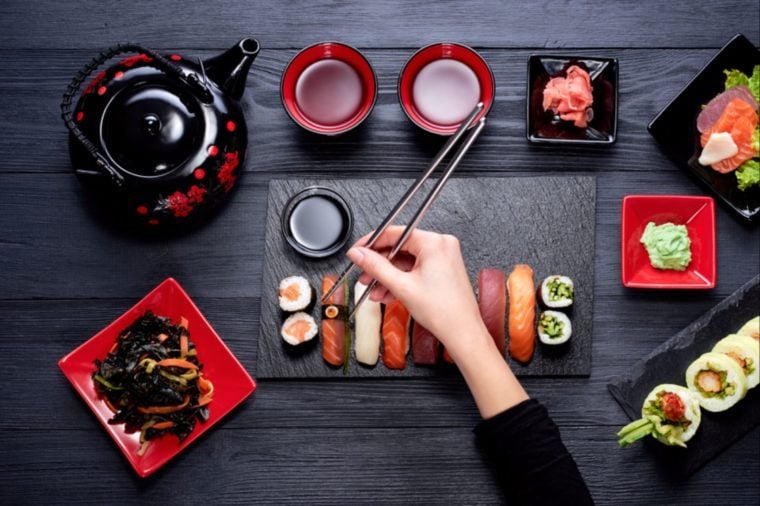 You probably didn't know there's a recommended order for eating sushi. For proper etiquette, you'll want to start with whitefish and lighter tasting fish, and follow with richer, more oily items, according to Jeffrey Elliot and Robby Cook, authors of The Complete Guide to Sushi and Sashimi. Think of it this way: You wouldn't start with a full-bodied red wine with your salad, and then switch to a light red with your steak dinner!
You probably didn't know there's a recommended order for eating sushi. For proper etiquette, you'll want to start with whitefish and lighter tasting fish, and follow with richer, more oily items, according to Jeffrey Elliot and Robby Cook, authors of The Complete Guide to Sushi and Sashimi. Think of it this way: You wouldn't start with a full-bodied red wine with your salad, and then switch to a light red with your steak dinner!
Don't put wasabi directly into your soy sauce
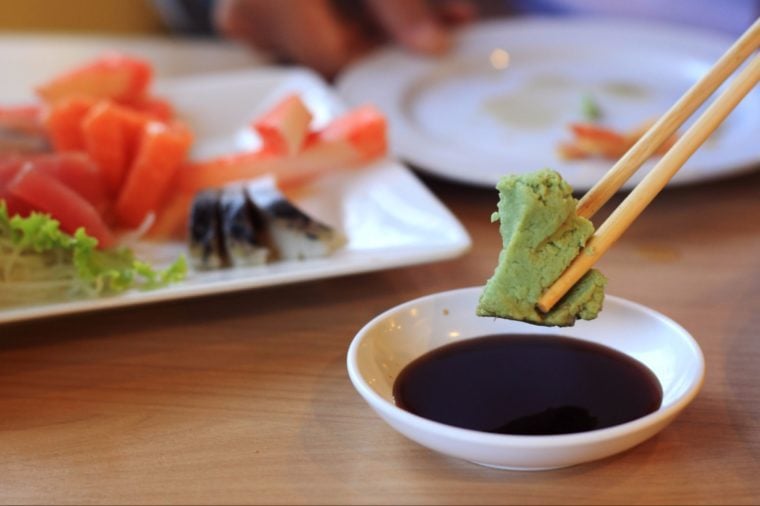 At nicer restaurants, the sushi chef has already placed the proper amount of wasabi and soy sauce on the fish to provide a perfect balance. However, if they have not, you'll want to make sure you have your dipping etiquette down. When dipping your nigiri or sushi into the soy sauce, simply put any additional wasabi directly onto the sushi. And speaking of soy sauce, you're probably dipping into it wrong! Be sure to dip your nigiri into the soy sauce fish-side down, otherwise the rice could fall apart, advises Chef Masaharu Morimoto of Morimoto in New York City. And besides, it just tastes better this way.
At nicer restaurants, the sushi chef has already placed the proper amount of wasabi and soy sauce on the fish to provide a perfect balance. However, if they have not, you'll want to make sure you have your dipping etiquette down. When dipping your nigiri or sushi into the soy sauce, simply put any additional wasabi directly onto the sushi. And speaking of soy sauce, you're probably dipping into it wrong! Be sure to dip your nigiri into the soy sauce fish-side down, otherwise the rice could fall apart, advises Chef Masaharu Morimoto of Morimoto in New York City. And besides, it just tastes better this way.
Finish what you order
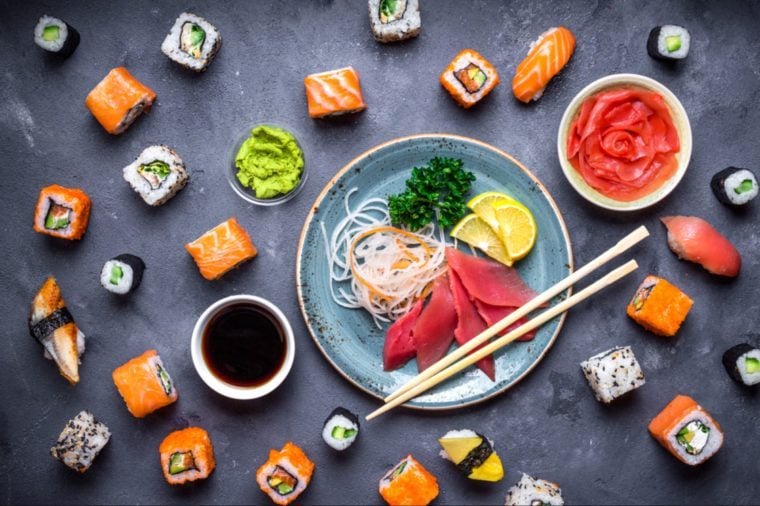 Perhaps it's a nice idea to leave food on your plate, so you don't look gluttonous, but in the Japanese culture, that's poor form. This is especially true if you opt for chef's choice, called omakase. Giving the chef the opportunity to make what they please for you is an honor, and so not finishing items is considered very rude and wasteful. That's a good reason to order only what you think you can eat—because too much sushi isn't healthy. It's also suggested that, as you enjoy your meal, you eat each piece of sushi as it's presented to you as opposed to letting items stack up on your plate. Chefs select the freshest items, and are meticulous about pacing out the meal correctly, as well as ensuring the temperature of the rice.
Perhaps it's a nice idea to leave food on your plate, so you don't look gluttonous, but in the Japanese culture, that's poor form. This is especially true if you opt for chef's choice, called omakase. Giving the chef the opportunity to make what they please for you is an honor, and so not finishing items is considered very rude and wasteful. That's a good reason to order only what you think you can eat—because too much sushi isn't healthy. It's also suggested that, as you enjoy your meal, you eat each piece of sushi as it's presented to you as opposed to letting items stack up on your plate. Chefs select the freshest items, and are meticulous about pacing out the meal correctly, as well as ensuring the temperature of the rice.
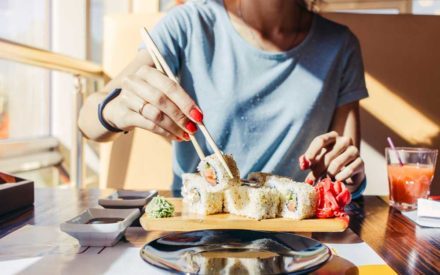
Comments
Post a Comment